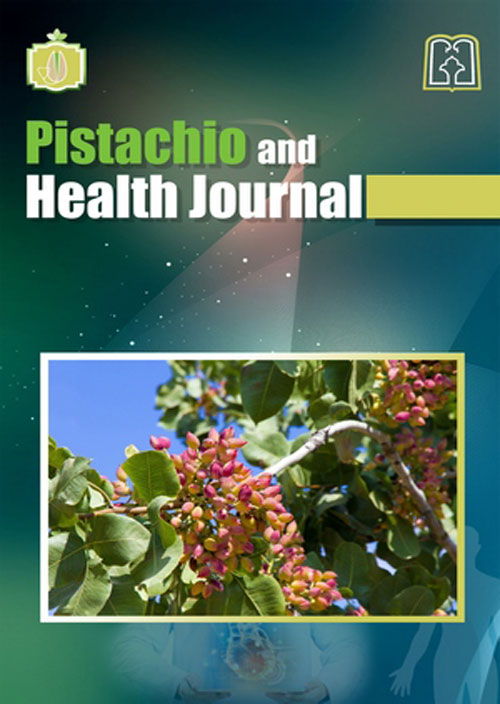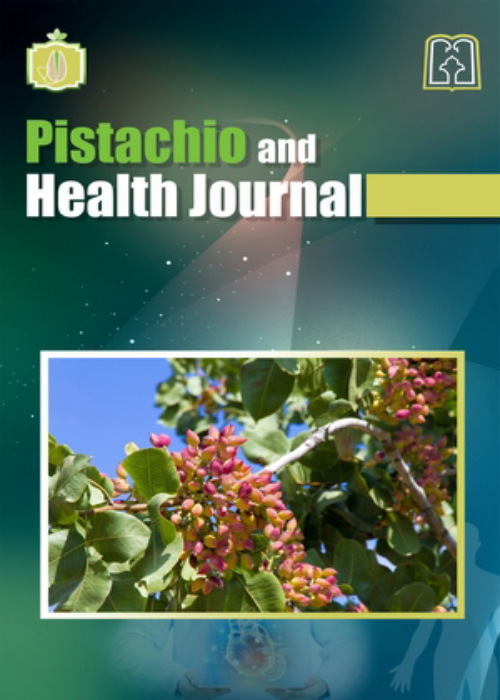فهرست مطالب

Pistachio and Health Journal
Volume:2 Issue: 3, Summer 2019
- تاریخ انتشار: 1398/06/10
- تعداد عناوین: 7
-
-
Pages 1-16Introduction
Diabetes is one of the most common metabolic disorders that is increasing at an alarming rate, for the prevention, control, and treatment of which an appropriate diet is needed. This study aims to examine effects of pistachio hydrolysates on blood glucose in streptozotocin-diabetic and high-sugar diet-fed rats.
Materials and MethodsThe prepared pistachio hydrolysates were administered to 96 rats that were divided into 12 groups, including 9 target groups and 3 control groups. The target groups were divided into three groups of rats with a normal diet, rats with a high-sugar diet, and streptozotocin-diabetic rats with a normal diet, which were fed on different doses of pistachio hydrolysates (5, 50, and 500 mg/kg) for 8 weeks. After 8 weeks, the levels of fasting blood glucose, two-hour postprandial glucose, fourhour postprandial glucose, HbA1c, and insulin were measured.
ResultsThe results showed that pistachio hydrolysates could significantly reduce the level of blood sugar in type 1 diabetic and high-sugar diet-fed rats compared to the control groups (P˂ 0.05). This research is the first one to have demonstrated that pistachio protein lysates have a strong effect on blood glucose in type 1 diabetic rats and the ones received a high-sugar diet. This treatment decreased the blood glucose level in the former but controlled glucose concentration in the latter. Besides, the results showed that HbA1c, FBG, two-hour postprandial glucose, and four-hour postprandial glucose decreased significantly, while the insulin level increased in rats having consumed pistachio hydrolysates (P˂ 0.05).
ConclusionIt is concluded that pistachio proteins could play a positive role in type 1 diabetic people and those having a high-sugar diet.
Keywords: Diabetes, High-Sugar Diet, pistachios, Protein Hydrolysates -
Pages 17-29Introduction
Plants have a wide range of secondary metabolites with antimicrobial activity such as polyphenols, quinines, flavonoids, and alkaloids, with most of them acting as a plant defense against pathogens. This study aimed to evaluate the in vitro activity of pistachio rosy hull extracts against Gram-positive (Bacillus cereus, Listeria monocytogenes, Staphylococcus aureus, and Streptococcus pyogenes), Gram-negative (Escherichia coli, Klebsiella pneumonia, and Pseudomonas aeruginosa), and clinical isolates including methicillin-resistant S. aureus (MRSA) bacterial strains.
Materials and MethodsThe antibacterial activity of extracts was determined using disc diffusion and microdilution broth methods. The synergistic effects and susceptibility pattern of clinical isolates were determined using antibiotic discs.
ResultsAll extracts of rosy hull showed a significant bacteriostatic and bactericidal effect on S. aureus. However, the aqueous extract was the most active one against MRSA strains. The MICs of the aqueous and methanolic hull extracts against S. aureus were 0.78 and 1.56 mg/mL, respectively. The MICs of the aqueous and methanolic hull extracts against MRSA strains were 3.12 and 6.25 mg/mL, respectively. Furthermore, in many cases, the extracts enhanced the action of antibiotics against Gram-positive bacteria including S. aureus and Listeria monocytogenes.
ConclusionsThe antibacterial activity of pistachio rosy hull was reported for the first time in this study. The results suggested that pistachio rosy hull is a rich source to be used to combat problems caused by MRSA in hospitals as well as S. aureus skin infections.
Keywords: antibacterial, MRSA, Pistachio hull, S. aureus -
Pages 30-40Introduction
A healthy diet and getting enough calories are important factors in health. Pistachios are rich in nutrients with healthy fatty acids, as well as protein, dietary fiber, potassium, magnesium, vitamins and have high antioxidant and anti-inflammatory properties. The aim of this study was to compare the consumption of two pistachios with 15 and 50 g on the health indicators of Aged women. With an interval of eight weeks, one group was given 50 grams of pistachios and one group was given 15 grams.
Materials and MethodsThis quasi-experimental study was performed on 40 Aged women in bam city. Participants were randomly divided into two groups of 20 people. Height, weight, blood pressure, blood sugar, blood lipid profiles and red blood cell indices were measured before and after the intervention. Data were analyzed using SPSS software version 18.
ResultsBefore the intervention, there was no significant difference between the two groups in any of the measured indices. After the intervention, there was no significant difference between the two groups except in the values of fasting blood sugar. So that with the independent ttest, fasting blood sugar in the group with consumption of 50 grams was 101.57± 22.07 and in the group of 15 grams was 89.11± 8.16 (P=0.03).
ConclusionDue to the positive effects on women's health indicators, which were observed in both doses of 15 and 50 g, according to the conditions and costs, it is recommended to add 15 g of pistachios to the diet of the elderly daily.
Keywords: Pistachio nut, Health Status Indicators, Elderly -
Pages 41-50Introduction
Pistachio cake is a product in which paste and powder of pistachios are used as its main ingredient. The use of paste and pistachio powder in the production of oily cake can improve the nutritional value and flavor of the product.
Materials and MethodsThe attributes of the oily cake include moisture, pH, color, texture; microbial evaluation (colony count, mold, yeast, Enterobacteriaceae) and sensory evaluation (by 6-point Hedonic method) was evaluated.
ResultsThere are significant differences in pH, moisture, color attributes (L*, a* and b*), stiffness, microbial evaluation and sensory evaluation in different treatments (P≤ 0.01). In all treatments, pH is decreased significantly compared to control (P≤ 0.05). Adding pistachio paste and powder in all quantities significantly increased the moisture content of cake (P≤ 0.05). Adding pistachio powder in all treatments caused texture hardness as compared with control (P≤ 0.05). For microbial evaluation, samples had less than 10 molds, yeast and enterobacteriacea in different treatments, indicating there was no contamination of the cake containing different amounts of pistachio powder and pistachio paste.
ConclusionThe cake containing 5% pistachio paste and 2.5% pistachio powder was the most favorable cake in terms of overall acceptability
Keywords: Confectionary, Color, Flavor, Mold, Texture, Yeas -
Pages 51-60Introduction
Despite nutritional and economic importance of pistachios, there are still many problems facing their production and marketing. Changes made in the quality of fresh pistachios during storage could reduce their shelf life. Thus, they should be consumed in a short period of time if not stored under proper conditions.
Materials and MethodsThis study was conducted using treatments of freezing (for 0, 1.5, and 3 months at -20 °C) and an alginate-based edible coating (at concentrations of 0, 0.5, and 1%) to increase durability of fresh pistachios in a completely randomized design. The measured parameters included moisture reduction, the peroxide value, and the phenolic content.
ResultsResults of the current research showed that freezing temperatures (up to 1.5 months) reduced the peroxide value of fresh pistachios. The use of an alginate-based edible coating (especially at the concentration of 1%) helped maintain some parameters of fresh pistachios, such as the moisture content and peroxide value.
ConclusionsQuality changes in fresh agricultural products during storage are mostly caused by enzyme activities and metabolic alterations. The use of chemical compounds is not welcomed by consumers due to their detrimental effects on the environment and human health. The freezing temperature could extend the shelf life of fresh products by decreasing their respiration rate. The other new technology employs edible coatings, such as alginates, to create a barrier on the surface of fruits to prevent water loss and gas exchange (oxygen and carbon dioxide).
Keywords: Alginates, Edible Coatings Freezing, Fresh Pistachios -
Pages 61-73Introduction
Peeling is one of the most important steps in pistachio processing. Optimizing the peeling step can improve the quality of the finished product.
Materials and MethodsIn this research, the technical function of two kinds of peeling machine (screw-blade and screw) and the manual peeling method were evaluated. The tested pistachio was Fandoghi in the ripening stage. The samples were peeled, the number of fully-peeled, partially-peeled, unpeeled, and broken nuts were counted, and the percentage of each one was determined. Then, the changes in peroxide value, shell and kernel color, texture, and sensory properties (taste, color, texture, and overall acceptance) were evaluated at different intervals of 0, 1, 2, 3, and 4 months. The experiment was conducted in a completely randomized design with the factorial arrangement.
ResultsThe results showed that the high percentage of fully-peeled nuts (87.95%) belonged to the screw-blade method. The percentage of partiallypeeled and broken nuts in the screw method was more comparable with the screw-blade machine. There was no considerable difference in the screw and screw-blade methods in terms of peroxide value. The manual peeling method was better in color attributes (L*, a*, b*) compared with screw-blade and screw methods. The highest taste, color, and overall acceptance rate belonged to the manual peeling method, showing a big difference from the other methods. The quality of color in the screw-blade method was more than that in the screw method.
ConclusionIn general, the screw-blade method is suggested to be used for peeling pistachio nuts.
Keywords: Pistachio, Peeling, Screw Peeler, Screw-Blade Peeler, Manual Peeling -
Pages 74-75


